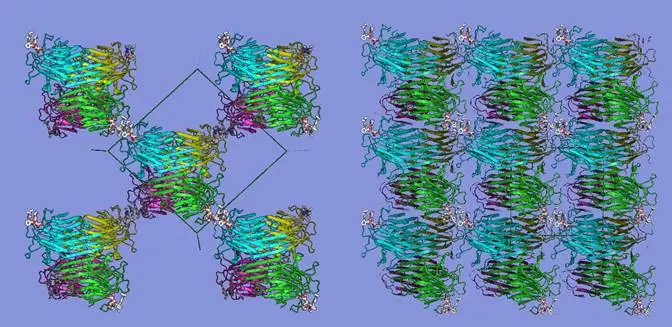Proteins: New class of materials discovered
German-Chinese research team gleans seminal insights into protein crystalline frameworks at HZB's BESSY II
Scientists at the Helmholtz Center Berlin (HZB) along with researchers at China’s Fudan University have characterized a new class of materials called protein crystalline frameworks (PCFs).
Thanks to certain helper substances, in PCFs proteins are fixated in a way so as to align themselves symmetrically, forming highly stable crystals. Next, the HZB and Fudan University researchers are planning on looking into how PCFs may be used as functional materials. Their findings are being published today in the scientific journal Nature Communications (DOI: 10.1038/ncomms5634).
Proteins are sensitive molecules. Everyone knows that – at least from having boiled eggs. Under certain circumstances – like immersion in boiling water – they denature, losing their natural shape, and becoming hard. True, researchers have been able to handle these substances for some time now, even to the point of crystallizing them in their native state. Admittedly, though, this does require considerable effort, but it is the only way how researchers can find out the structure of these substances at high resolution. Moreover, protein crystals are extremely fragile, highly sensitive and hard to handle.
Now, for the first time ever, scientists at China's Fudan University have managed to work around these downsides by linking the protein concanavalin A to helper molecules belonging to the sugar family, and to the dye rhodamin. The concanavalin molecules that have been thus fixated tended to arrange themselves symmetrically within the helper molecule framework, forming crystals, in which the proteins achieve high stability and are intricately interconnected – into a protein crystalline framework.
Developing molecular structures like these is pointless unless you know exactly how they form and what their structure looks like at the level of the atoms. During the quest for suitable experimental methods, the Shanghai researchers turned to a Chinese scientist working at the HZB for help. She called her colleagues' attention to the MX beamlines at the HZB's electron storage ring BESSY II.
"Here at the HZB, we were able to offer them our highly specialized crystallography stations – the perfect venue for characterizing PCFs at high resolutions," says Dr. Manfred Weiss, one of the leading scientists working at the HZB-MX laboratory. It quickly became clear that the helper molecules even allowed the researchers to decide how powerfully they wanted them to penetrate the protein frameworks. "This gives the PCFs a great deal of flexibility and variability, which we’ll always keep in mind when doing research on potential applications," says Manfred Weiss.
Original publication:
Sakai, F. et al. Protein crystalline frameworks with controllable interpenetration directed by dual supramolecular interactions.
Nat. Commun. 5:4634 doi: 10.1038/ncomms5634 (2014).
Further Information:
Dr. Manfred Weiss
Institute Soft Matter and Functional Materials
Tel.: +49 (0)30-8062-13149
manfred.weiss(at)helmholtz-berlin.de
Hannes Schlender
Media relations
Tel.: +49 (0)30-8062-42414
hannes.schlender(at)helmholtz-berlin.de
